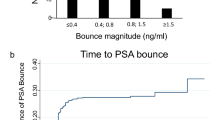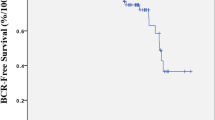Abstract
Background
The objectives are to determine predictors of a prostate-specific antigen (PSA) bounce, whether a PSA bounce after radiotherapy for prostate cancer is associated with biochemical disease-free survival (bDFS), and the time course to a PSA bounce versus a biochemical failure post-irradiation.
Methods
Between July 2000 and December 2012, 691 prostate cancer patients without regional or distant metastases were treated with external beam radiation therapy and/or brachytherapy, and had at least 12 months of follow-up. A PSA bounce was defined as a temporary PSA increase of ≥0.4 ng/mL. bDFS was defined according to the nadir + 2 definition.
Results
The median follow-up was 42 months. The median time to first PSA bounce was 17 months (95 % confidence interval 15–18 months). In contrast, the median time to biochemical failure was 41 months (95 % confidence interval 28–53 months). Two hundred and twenty-six of 691 (33 %) patients had at least one PSA bounce with a median magnitude of 1.0 ng/mL (range 0.4–17.0). A Gleason score of 6 (p < 0.0001) predicted a PSA bounce on multivariate analysis. Patients with a PSA bounce experienced improved bDFS on multivariate analysis (p = 0.002).
Conclusions
Patients with a Gleason score of 6 were more likely to experience a PSA bounce which was associated with improved bDFS. A PSA bounce occurred sooner after radiotherapy than a biochemical failure. The authors recommend against performing prostate biopsies within 24–30 months of radiotherapy since an elevated PSA may simply represent a benign PSA bounce.


Similar content being viewed by others
References
Sheinbein C, Teh BS, Mai WY et al (2010) Prostate-specific antigen bounce after intensity-modulated radiotherapy for prostate cancer. Urology 76:728–733
Akyol F, Ozyigit G, Selek U et al (2005) PSA bouncing after short term androgen deprivation and 3D-conformal radiotherapy for localized prostate adenocarcinoma and the relationship with the kinetics of testosterone. Eur Urol 48:40–45
Caloglu M, Ciezki JP, Reddy CA et al (2011) PSA bounce and biochemical failure after brachytherapy for prostate cancer: a study of 820 patients with a minimum of 3 years of follow-up. Int J Radiat Oncol Biol Phys 80:735–741
Horwitz EM, Levy LB, Thames HD et al (2006) Biochemical and clinical significance of the posttreatment prostate-specific antigen bounce for prostate cancer patients treated with external beam radiation therapy alone: a multiinstitutional pooled analysis. Cancer 107:1496–1502
Mohler JL, Armstrong AJ, Bahnson RR et al (2012) Prostate cancer, version 3.2012: featured updates to the NCCN guidelines. J Natl Compr Canc Netw 10:1081–1087
Edge SB, Compton CC (2010) The American Joint Committee on Cancer: the 7th edition of the AJCC cancer staging manual and the future of TNM. Ann Surg Oncol 17:1471–1474
Ghilezan M, Martinez A, Gustason G et al (2012) High-dose-rate brachytherapy as monotherapy delivered in two fractions within one day for favorable/intermediate-risk prostate cancer: preliminary toxicity data. Int J Radiat Oncol Biol Phys 83:927–932
Davis BJ, Horwitz EM, Lee WR et al (2012) American Brachytherapy Society consensus guidelines for transrectal ultrasound-guided permanent prostate brachytherapy. Brachytherapy 11:6–19
Yamada Y, Rogers L, Demanes DJ et al (2012) American Brachytherapy Society consensus guidelines for high-dose-rate prostate brachytherapy. Brachytherapy 11:20–32
Castle KO, Hoffman KE, Levy LB et al (2013) Is androgen deprivation therapy necessary in all intermediate-risk prostate cancer patients treated in the dose escalation era? Int J Radiat Oncol Biol Phys 85:693–699
Huang J, Vicini FA, Williams SG et al (2012) Percentage of positive biopsy cores: a better risk stratification model for prostate cancer? Int J Radiat Oncol Biol Phys 83:1141–1148
Vetterli D, Thalmann S, Behrensmeier F et al (2006) Daily organ tracking in intensity-modulated radiotherapy of prostate cancer using an electronic portal imaging device with a dose saving acquisition mode. Radiother Oncol 79:101–108
Shaffer R, Morris WJ, Moiseenko V et al (2009) Volumetric modulated Arc therapy and conventional intensity-modulated radiotherapy for simultaneous maximal intraprostatic boost: a planning comparison study. Clin Oncol (R Coll Radiol) 21:401–407
Martinez AA, Gonzalez J, Ye H et al (2011) Dose escalation improves cancer-related events at 10 years for intermediate- and high-risk prostate cancer patients treated with hypofractionated high-dose-rate boost and external beam radiotherapy. Int J Radiat Oncol Biol Phys 79:363–370
Roach M 3rd, Hanks G, Thames H Jr et al (2006) Defining biochemical failure following radiotherapy with or without hormonal therapy in men with clinically localized prostate cancer: recommendations of the RTOG-ASTRO Phoenix Consensus Conference. Int J Radiat Oncol Biol Phys 65:965–974
Komatsu K, Wehner N, Prestigiacomo AF et al (1996) Physiologic (intraindividual) variation of serum prostate-specific antigen in 814 men from a screening population. Urology 47:343–346
Prestigiacomo AF, Stamey TA (1996) Physiological variation of serum prostate specific antigen in the 4.0 to 10.0 ng./ml. range in male volunteers. J Urol 155:1977–1980
Pickles T, British Columbia Cancer Agency Prostate Cohort Outcomes I (2006) Prostate-specific antigen (PSA) bounce and other fluctuations: which biochemical relapse definition is least prone to PSA false calls? An analysis of 2030 men treated for prostate cancer with external beam or brachytherapy with or without adjuvant androgen deprivation therapy. Int J Radiat Oncol Biol Phys 64:1355–1359
Ciezki JP, Reddy CA, Garcia J et al (2006) PSA kinetics after prostate brachytherapy: PSA bounce phenomenon and its implications for PSA doubling time. Int J Radiat Oncol Biol Phys 64:512–517
Merrick GS, Butler WM, Wallner KE et al (2002) Prostate-specific antigen spikes after permanent prostate brachytherapy. Int J Radiat Oncol Biol Phys 54:450–456
Mehta NH, Kamrava M, Wang PC et al (2013) Prostate-specific antigen bounce after high-dose-rate monotherapy for prostate cancer. Int J Radiat Oncol Biol Phys 86:729–733
Cavanagh W, Blasko JC, Grimm PD et al (2000) Transient elevation of serum prostate-specific antigen following (125)I/(103)Pd brachytherapy for localized prostate cancer. Semin Urol Oncol 18:160–165
Critz FA, Williams WH, Benton JB et al (2000) Prostate specific antigen bounce after radioactive seed implantation followed by external beam radiation for prostate cancer. J Urol 163:1085–1089
Gaztanaga M, Crook J (2013) Interpreting a rising prostate-specific antigen after brachytherapy for prostate cancer. Int J Urol 20:142–147
Das P, Chen MH, Valentine K et al (2002) Using the magnitude of PSA bounce after MRI-guided prostate brachytherapy to distinguish recurrence, benign precipitating factors, and idiopathic bounce. Int J Radiat Oncol Biol Phys 54:698–702
Rosser CJ, Kamat AM, Wang X et al (2005) Is patient age a factor in the occurrence of prostate-specific antigen bounce phenomenon after external beam radiotherapy for prostate cancer? Urology 66:327–331
Stone NN (2013) Editorial Comment from Dr Stone to interpreting a rising prostate-specific antigen after brachytherapy for prostate cancer. Int J Urol 20:148
Feigenberg SJ, Hanlon AL, Horwitz EM et al (2006) A prostate specific antigen (PSA) bounce greater than 1.4 ng/mL Is clinically significant after external beam radiotherapy for prostate cancer. Am J Clin Oncol 29:458–462
Conflict of interest
The authors have no direct or indirect commercial financial incentives or sources of funding associated with publishing the manuscript.
Author information
Authors and Affiliations
Corresponding author
About this article
Cite this article
Naghavi, A.O., Strom, T.J., Nethers, K. et al. Clinical implications of a prostate-specific antigen bounce after radiation therapy for prostate cancer. Int J Clin Oncol 20, 598–604 (2015). https://doi.org/10.1007/s10147-014-0745-8
Received:
Accepted:
Published:
Issue Date:
DOI: https://doi.org/10.1007/s10147-014-0745-8




